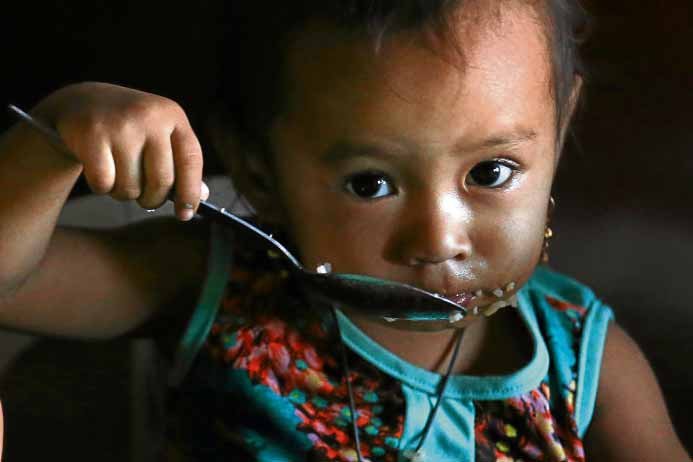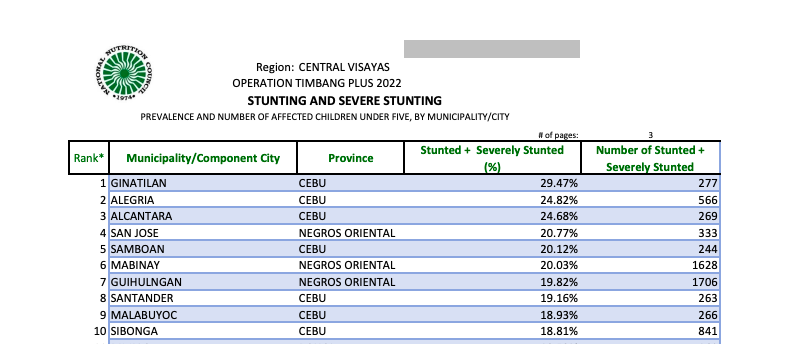
FEEDING TIME A child eats rice porridge and adobo at a feeding session held in Baseco, Tondo, Manila. According to Unicef, malnutrition is partly driven by the increasing availability of processed food, especially to poor families. —INQUIRER FILE PHOTO
FIRST OF THREE PARTS
CEBU CITY, Philippines — In Central Visayas, the Municipality of Ginatilan in Cebu has the highest prevalence rate for stunting for children under five years old, the 2022 Operation Timbang Plus (OPT) report shows.
The National Nutrition Council in Central Visayas (NNC 7) said that of the total population of children under five years old in Ginatilan, 29.47 percent of them, or 277 children in this age group, are stunted.
Ginatilan is followed by Alcantara (24.68 percent, or 269 children) and Alegria (24.82 percent, or 566 stunted children).
READ: Buwad, ginamos, noodles: A struggling family shows why nutrition is least of their worries

Data from NNC 7 official website
The highly urbanized cities of Cebu, Mandaue, and Lapu-Lapu are ranked 77th, 95th, and 116th, respectively, out of the 132 local government units (LGUs) in the region. Cebu City registered a malnutrition prevalence rate of 6.96 percent; Mandaue City at 5.46 percent, and Lapu-Lapu City at 2.32 percent.
The World Health Organization (WHO) defines stunting as the impaired growth and development that children experience “from poor nutrition, repeated infection, and inadequate psychosocial stimulation.”
Children are defined as stunted if their height-for-age is more than two standard deviations below the WHO Child Growth Standards median, WHO said.
‘Slightly improved’ nutrition in Central Visayas
Parolita Mission, NNC-7 nutrition program coordinator, however, noted that the region’s nutrition statistics, in general, has slightly improved in 2022 compared to 2021.
“As the COVID-19 situation in the country stabilizes, so does the nutrition situation in Central Visayas as the health and nutrition systems gain a foothold back into the regular nutrition services,” she said.
Malnutrition manifests as underweight, stunted growth, wasting or extreme thinness and even obesity.
READ MORE: Feeding hungry kids
Among the types of malnutrition, stunting or chronic malnutrition which has the greatest impact especially to the cognitive development of children continues to decrease in both prevalence (from 9.7% in 2021 to 8.5% in 2022) and magnitude (from 72,179 children in 2021 to 55,741 children in 2022).
The same declining trend is also evident in underweight and overweight and obesity prevalence in the region.
Prevalence refers to the proportion of persons in a population having a particular condition.
The NNC 7 noted that while the underweight prevalence in Central Visayas increased from 3.97 percent in 2019 to 4.9 percent in 2021, it has returned to 3.6 percent in 2022. Overweight and obesity prevalence rate in the region also declined to 2.78 percent in 2022 from 3.1 percent in 2021.
Likewise, wasting or acute malnutrition, usually caused by a bout of infections, has declined from 17,884 children in 2021 to 14,503 children in 2022.
Threat to nutrition
The agency, however, acknowledged that this small progress in the state of nutrition in Central Visayas is threatened by a high poverty incidence estimated at 22.1 percent in 2021 (higher than the national prevalence rate of 13.2 percent) according to the Philippine Statistics Authority.
This means that one in every five families in the region have income below the amount needed to buy basic food and non-food needs.
READ MORE: Malnutrition rises in Cebu
The 2022 WHO Food Security Monitoring Report also showed that Central Visayas is the 4th food insecure region in the country with a food insecurity prevalence of 17.2 percent.
“Issues for food and nutrition security do not stop there as the quality of food consumption in the country also suffers which shows a high consumption of sugars and oils over fruits and meat respectively,” NNC 7 added.
to be continued…
RELATED STORIES:
49th Nutrition Month kicks off in Cebu City, grow own foods expert says
Baby with severe malnutrition needs urgent help

